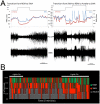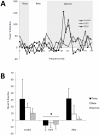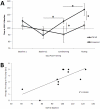Odor fear conditioning modifies piriform cortex local field potentials both during conditioning and during post-conditioning sleep
- PMID: 21448432
- PMCID: PMC3063180
- DOI: 10.1371/journal.pone.0018130
Odor fear conditioning modifies piriform cortex local field potentials both during conditioning and during post-conditioning sleep
Abstract
Background: Sleep plays an active role in memory consolidation. Sleep structure (REM/Slow wave activity [SWS]) can be modified after learning, and in some cortical circuits, sleep is associated with replay of the learned experience. While the majority of this work has focused on neocortical and hippocampal circuits, the olfactory system may offer unique advantages as a model system for exploring sleep and memory, given the short, non-thalamic pathway from nose to primary olfactory (piriform cortex), and rapid cortex-dependent odor learning.
Methodology/principal findings: We examined piriform cortical odor responses using local field potentials (LFPs) from freely behaving Long-Evans hooded rats over the sleep-wake cycle, and the neuronal modifications that occurred within the piriform cortex both during and after odor-fear conditioning. We also recorded LFPs from naïve animals to characterize sleep activity in the piriform cortex and to analyze transient odor-evoked cortical responses during different sleep stages. Naïve rats in their home cages spent 40% of their time in SWS, during which the piriform cortex was significantly hypo-responsive to odor stimulation compared to awake and REM sleep states. Rats trained in the paired odor-shock conditioning paradigm developed enhanced conditioned odor evoked gamma frequency activity in the piriform cortex over the course of training compared to pseudo-conditioned rats. Furthermore, conditioned rats spent significantly more time in SWS immediately post-training both compared to pre-training days and compared to pseudo-conditioned rats. The increase in SWS immediately after training significantly correlated with the duration of odor-evoked freezing the following day.
Conclusions/significance: The rat piriform cortex is hypo-responsive to odors during SWS which accounts for nearly 40% of each 24 hour period. The duration of slow-wave activity in the piriform cortex is enhanced immediately post-conditioning, and this increase is significantly correlated with subsequent memory performance. Together, these results suggest the piriform cortex may go offline during SWS to facilitate consolidation of learned odors with reduced external interference.
Conflict of interest statement
Figures





Similar articles
-
Generalized vs. stimulus-specific learned fear differentially modifies stimulus encoding in primary sensory cortex of awake rats.J Neurophysiol. 2011 Dec;106(6):3136-44. doi: 10.1152/jn.00721.2011. Epub 2011 Sep 14. J Neurophysiol. 2011. PMID: 21918001 Free PMC article.
-
Slow-wave sleep-imposed replay modulates both strength and precision of memory.J Neurosci. 2014 Apr 9;34(15):5134-42. doi: 10.1523/JNEUROSCI.5274-13.2014. J Neurosci. 2014. PMID: 24719093 Free PMC article.
-
Neonatal odor-shock conditioning alters the neural network involved in odor fear learning at adulthood.Learn Mem. 2008 Aug 26;15(9):649-56. doi: 10.1101/lm.998508. Print 2008 Sep. Learn Mem. 2008. PMID: 18772252 Free PMC article.
-
Sleep and olfactory cortical plasticity.Front Behav Neurosci. 2014 Apr 22;8:134. doi: 10.3389/fnbeh.2014.00134. eCollection 2014. Front Behav Neurosci. 2014. PMID: 24795585 Free PMC article. Review.
-
Cellular correlates of olfactory learning in the rat piriform cortex.Rev Neurosci. 2001;12(2):111-20. doi: 10.1515/revneuro.2001.12.2.111. Rev Neurosci. 2001. PMID: 11392453 Review.
Cited by
-
Neuropeptide S facilitates mice olfactory function through activation of cognate receptor-expressing neurons in the olfactory cortex.PLoS One. 2013 Apr 16;8(4):e62089. doi: 10.1371/journal.pone.0062089. Print 2013. PLoS One. 2013. PMID: 23614017 Free PMC article.
-
Ecologically relevant neurobehavioral assessment of the development of threat learning.Learn Mem. 2016 Sep 15;23(10):556-66. doi: 10.1101/lm.042218.116. Print 2016 Oct. Learn Mem. 2016. PMID: 27634146 Free PMC article. Review.
-
Single-neuron responses to intraoral delivery of odor solutions in primary olfactory and gustatory cortex.J Neurophysiol. 2017 Mar 1;117(3):1293-1304. doi: 10.1152/jn.00802.2016. Epub 2016 Dec 21. J Neurophysiol. 2017. PMID: 28003413 Free PMC article.
-
Aversive learning-induced plasticity throughout the adult mammalian olfactory system: insights across development.J Bioenerg Biomembr. 2019 Feb;51(1):15-27. doi: 10.1007/s10863-018-9770-z. Epub 2018 Aug 31. J Bioenerg Biomembr. 2019. PMID: 30171506 Free PMC article. Review.
-
Stimulus-specific enhancement of fear extinction during slow-wave sleep.Nat Neurosci. 2013 Nov;16(11):1553-5. doi: 10.1038/nn.3527. Epub 2013 Sep 22. Nat Neurosci. 2013. PMID: 24056700 Free PMC article.
References
-
- McCarley RW. Neurobiology of REM and NREM sleep. Sleep Med. 2007;8:302–330. - PubMed
-
- Rauchs G, Desgranges B, Foret J, Eustache F. The relationships between memory systems and sleep stages. J Sleep Res. 2005;14:123–140. - PubMed
-
- Diekelmann S, Wilhelm I, Born J. The whats and whens of sleep-dependent memory consolidation. Sleep Med Rev. 2009;13:309–321. - PubMed
Publication types
MeSH terms
Grants and funding
LinkOut - more resources
Full Text Sources

